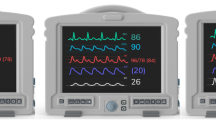Abstract
Background
Electroencephalographic monitoring is being used with increasing frequency in critically ill children who may require frequent and sometimes urgent brain CT scans. Standard metallic disk EEG electrodes commonly produce substantial imaging artifact, and they must be removed and later reapplied when CT scans are indicated.
Objective
To determine whether conductive plastic electrodes caused artifact that limited CT interpretation.
Material and methods
We describe a retrospective cohort of 13 consecutive critically ill children who underwent 17 CT scans with conductive plastic electrodes during 1 year. CT images were evaluated by a pediatric neuroradiologist for artifact presence, type and severity.
Results
All CT scans had excellent quality images without artifact that impaired CT interpretation except for one scan in which improper wire placement resulted in artifact.
Conclusion
Conductive plastic electrodes do not cause artifact limiting CT scan interpretation and may be used in critically ill children to permit concurrent electroencephalographic monitoring and CT imaging.

Similar content being viewed by others
References
Sanchez SM, Carpenter J, Chapman KE et al (2013) Pediatric ICU EEG monitoring: current resources and practice in the United States and Canada. J Clin Neurophysiol 30:156–160
Abend NS, Topjian AA, Gutierrez-Colina AM et al (2011) Impact of continuous EEG monitoring on clinical management in critically ill children. Neurocrit Care 15:70–75
Abend NS, Arndt DH, Carpenter JL et al (2013) Electrographic seizures in pediatric ICU patients: cohort study of risk factors and mortality. Neurology 81:383–391
Wagenman KL, Blake TP, Sanchez SM et al (2014) Electrographic status epilepticus and long-term outcome in critically ill children. Neurology 4:396–404
Das RR, Lucey BP, Chou SH et al (2009) The utility of conductive plastic electrodes in prolonged ICU EEG monitoring. Neurocrit Care 10:368–372
Vulliemoz S, Perrig S, Pellise D et al (2009) Imaging compatible electrodes for continuous electroencephalogram monitoring in the intensive care unit. J Clin Neurophysiol 26:236–243
Abend NS, Gutierrez-Colina AM, Topjian AA et al (2011) Nonconvulsive seizures are common in critically ill children. Neurology 76:1071–1077
Mirsattari SM, Davies-Schinkel C, Young GB et al (2009) Usefulness of a 1.5 T MRI-compatible EEG electrode system for routine use in the intensive care unit of a tertiary care hospital. Epilepsy Res 84:28–32
Acknowledgements
Dr. Abend is supported by a grant from the National Institutes of Health (K23NS076550).
Conflicts of interest
None
Author information
Authors and Affiliations
Corresponding author
Rights and permissions
About this article
Cite this article
Abend, N.S., Dlugos, D.J., Zhu, X. et al. Utility of CT-compatible EEG electrodes in critically ill children. Pediatr Radiol 45, 714–718 (2015). https://doi.org/10.1007/s00247-014-3208-5
Received:
Revised:
Accepted:
Published:
Issue Date:
DOI: https://doi.org/10.1007/s00247-014-3208-5




